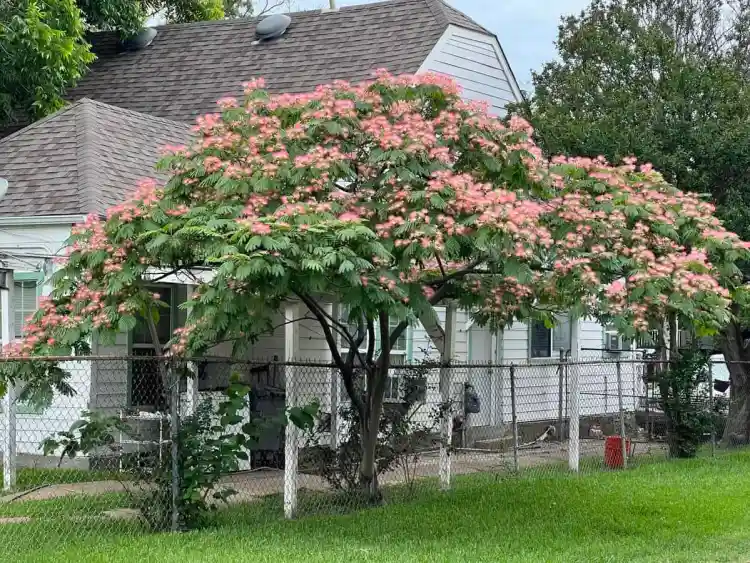Mimosa Tree Good for Firewood
When it comes to choosing the correct trees for firewood, one may question the suitability of the mimosa tree. In this extensive guide, we look into the question: Is the mimosa tree good for firewood? Understanding the attributes, burning qualities, and implications of using mimosa wood for firewood is critical for making sound judgments. Mimosa trees, famed for their unusual pink, fluffy blooms and fern-like foliage, offer properties that make them appealing candidates for fuel. However, before harvesting and using mimosa wood for this purpose, it is critical to investigate several issues, including density, burning properties, environmental impact, and safety concerns. Individuals can assess whether the mimosa tree is a good choice for firewood by looking at these factors.
Is mimosa tree good for firewood?
Yes, mimosa wood can be used as firewood, although it burns quickly and may require more regular refueling than denser hardwoods.
Understanding Mimosa Trees
Mimosa trees, formally known as Albizia julibrissin, are deciduous trees that originated in Asia, mainly China and Iran, but have since spread around the world. These trees are known for their ornamental splendor, with bright pink, fluffy blossoms that resemble powder puffs and delicate, fern-like foliage. Mimosa trees grow quickly, reaching heights of 30 feet or more. They thrive in warm climes and are commonly grown for their aesthetic value in gardens, parks, and landscapes.

Mimosa trees are prized mostly for their beauty and shade, but they also have other significant characteristics. Mimosa trees’ wood is lightweight and easy to work with, making it ideal for a variety of woodworking tasks. Furthermore, components of the mimosa tree, such as the bark and leaves, have been utilized in traditional medicine for their supposed health advantages.
Understanding mimosa trees’ traits and development habits is critical for making informed decisions regarding their suitability for various applications, including potential usage as firewood.
Properties of Mimosa Wood
Mimosa wood, derived from the mimosa tree (Albizia julibrissin), has several distinct qualities that make it appropriate for a variety of purposes.
Lightweight: Mimosa wood is lightweight, making it easy to handle and work with. This feature makes it particularly useful for woodworking applications where heavy or dense wood is impractical.
Easy to Work: Mimosa wood is easy to cut, shape, and carve because of its delicate feel. Woodworkers like its versatility, which allows for fine details and precision craftsmanship.
Attractive Grain: Mimosa wood has an appealing grain pattern, with swirls and imperfections that provide character to final goods. Due to its natural beauty, it is a popular material for furniture, cabinetry, and ornamental objects.
Moderate Durability: Although mimosa wood is not as durable as some hardwoods, it is strong and stable enough for many indoor uses. When properly cleaned and finished, mimosa wood can resist considerable wear and tear.

Mimosa wood’s lightweight, workability, and aesthetic appeal make it an excellent choice for a variety of woodworking projects, from furniture construction to artistic endeavors.
Burning Qualities of Mimosa Wood
Mimosa wood is commonly used as firewood due to its excellent burning properties, but there are certain things to keep in mind.
Heat Output: Mimosa wood produces moderate heat when burned, making it ideal for heating smaller spaces like interior fireplaces or outdoor fire pits. While it does not provide as much heat as some hardwoods, it does provide enough warmth for a comfortable environment.
Flame Characteristics: When ignited, mimosa wood generates a steady flame with little smoke. This makes it an appealing option for outdoor parties or inside heating because it produces a lovely fire with minimal smoke emissions.
Ease of Ignition: Mimosa wood is relatively simple to ignite, requiring little effort to begin a fire. This makes it ideal for use in fireplaces, wood stoves, and campfires, where quick ignition is required.
Aroma: When burned, mimosa wood emits a mellow, pleasant perfume that contributes to the overall mood of a fire. This gentle aroma improves the outdoor experience and creates a warm atmosphere when used indoors.
Residue: While mimosa wood produces less ash residue than other types of firewood, it does leave a tiny quantity of ash after burning. To keep the burning environment clean, it is advised that ash be disposed of properly.
Factors to Consider
When deciding if mimosa trees are acceptable for firewood, various things should be considered, including Consider the number of mimosa trees in your area and if harvesting them for firewood is viable.
Wood Quality: Determine the quality of mimosa wood for burning, including density, moisture content, and overall condition.
Burn features: Evaluate mimosa wood’s burning properties, including heat production, flame features, and ease of igniting.
Environmental Impact: Think about the environmental impact of using mimosa trees for firewood, including any potential ecological consequences from harvesting them.
Alternative Uses: Before using mimosa trees simply for fuel, consider landscaping or habitat restoration.
Local Regulations: Be aware of any local regulations or limits that may apply to harvesting mimosa trees or utilizing them for firewood in your region.
By carefully considering these aspects, you can make an informed judgment regarding whether mimosa trees are a good supply of firewood for you.
Related Posts:
Using Mimosa Wood for Firewood
Using mimosa wood for firewood can be a realistic choice in some situations. Mimosa wood, recognized for its pleasant fragrance and rapid growth, can be a practical source of fuel for heating and cooking. However, there are a few things to consider while utilizing mimosa wood as firewood.
For starters, mimosa wood burns far faster than hardwoods like oak or maple. While this might be useful for swiftly producing heat, it may demand more frequent refueling, particularly during extended periods of cold weather.
Furthermore, mimosa wood produces moderate heat and a lovely aroma when burned, making it appropriate for use in fireplaces, wood stoves, and outdoor fire pits. However, its low density may lead to faster consumption than denser hardwoods.
Furthermore, mimosa wood should be carefully seasoned before use to reduce moisture content and improve burning efficiency. Properly seasoned wood burns cleaner and causes less smoke and creosote accumulation in chimneys, lowering the risk of chimney fires.
Overall, while mimosa wood may not be the most efficient or long-lasting firewood alternative, it is still a viable fuel source for individuals seeking a convenient and aromatic firewood option.
FAQS
Can mimosa wood be used in cooking?
Yes, but it is not recommended due to the risk of toxin release during combustion.
Is mimosa wood appropriate for interior fireplaces?
It is preferable to avoid burning mimosa wood indoors due to the increased risk of creosote development.
Does burning mimosa wood emit a pleasant aroma?
When burned, mimosa wood emits a lovely scent that some people enjoy.
How long does mimosa wood need to be seasoned before use?
Mimosa wood normally requires at least 6-12 months of seasoning to reach its appropriate moisture content.
Is mimosa wood easily split?
Mimosa wood is reasonably easy to split when green, but it may become more difficult as it dries.
Conclusion
To summarize, Is mimosa tree good for firewood, While mimosa wood can be burned as firewood, it has both advantages and disadvantages. Understanding its features, burning characteristics, and safety concerns is critical for making informed judgments about its use. Mimosa wood can create a unique burning experience, whether in outdoor fire pits or fireplaces, but it must be handled and monitored carefully to guarantee safety and efficiency.




